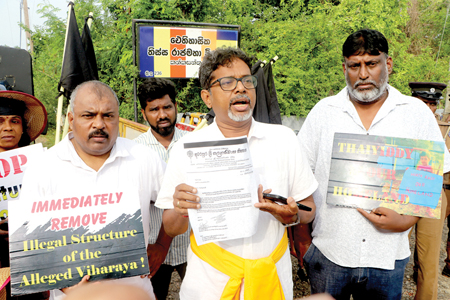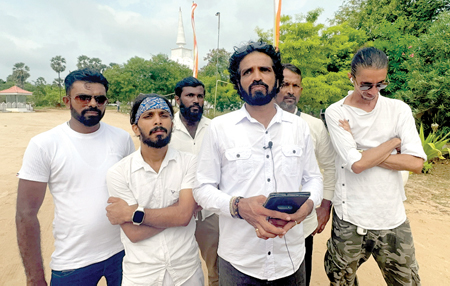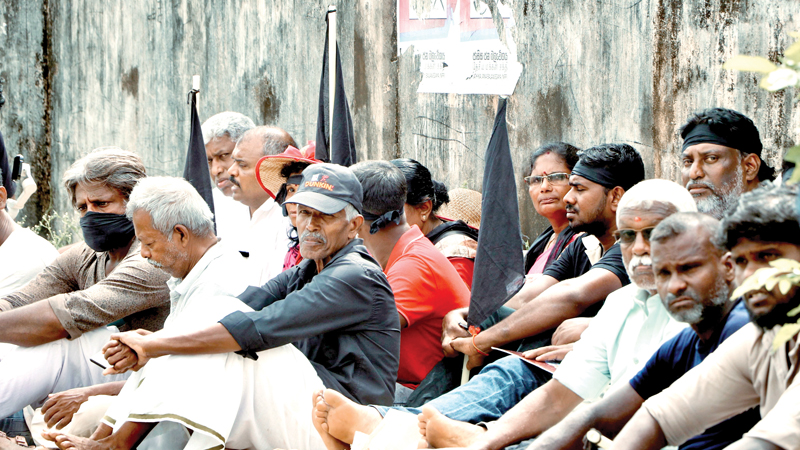 Following months of growing friction surrounding the Tissa Raja Maha Vihara in Jaffna, a new wave of unrest is taking shape, fuelled by religious symbolism, land disputes, and politically charged narratives. In continuation of the Sunday Observer’s earlier coverage on how religious and national symbols are increasingly being misused in election campaigns, recent events around the temple on Poya days have underscored how sacred spaces are being drawn into broader ethnic and political agendas.
Following months of growing friction surrounding the Tissa Raja Maha Vihara in Jaffna, a new wave of unrest is taking shape, fuelled by religious symbolism, land disputes, and politically charged narratives. In continuation of the Sunday Observer’s earlier coverage on how religious and national symbols are increasingly being misused in election campaigns, recent events around the temple on Poya days have underscored how sacred spaces are being drawn into broader ethnic and political agendas.
For the past several months, groups from the South have consistently travelled to the temple during each Poya day, especially on religious observances like Vesak and Poson. These visits have sparked protests from local Tamil villagers and landowners, many of whom say that their lands are being encroached upon and continue to demand the return of what they see as illegally occupied property. Clashes, verbal in nature, have periodically erupted, with both sides accusing each other of provocation, a situation that has been exacerbated by politically motivated actors and extremist voices on either side.
Tensions peaked on Vesak Poya day, May 12, when a group from the south arrived at the temple, coinciding with yet another protest from local residents. A heated argument broke out between the protesters and the police, reportedly sparked by attempts to park a privately owned Colombo-Kankesanthurai bus near the temple premises. This incident quickly escalated on social media, with some Sinhala users falsely framing the events as an “attack on Sinhalese devotees,” and rallying others to organise a large-scale presence at the temple for Poson Poya in June a call that gained traction under slogans like “protect our temple” and “travel north with 100,000 people.”
As tensions mount and social media becomes a tool for mobilisation and misinformation, the situation at Tissa Vihara risks becoming a flashpoint not only for religious sentiments but for deeper ethnic and political divides, particularly in a post-election climate where nationalist rhetoric is once again gaining visibility.
Mounting discord
In the wake of relentless communal friction, the Tissa Raja Maha Vihara, now formally under the Amarapura Sri Kalyaniwansa Sect, has become a flashpoint for misinformation, and divisive political manoeuvring.

Nadarajar Kandeepan and Selvarajah
On May 29, 2025, the Chief Thera of the sect, Ven. Pussellawe Somavisudhdhi Thera, issued a public statement denying any authorisation for Poson Day events at the Jaffna temple. He called upon all groups “not to behave in a manner that creates conflict situations between communities” and reminded them that “discussions with the Government have started regarding the Tissa Vihara” in refrence to the land disupute. The letter aimed to preempt messaging that might inflame ethnic tensions centred on religious observance.
Yet despite this official clarification, rumours spread throughout early June on social media about “One- hundred-thousand” people from the South planning a pilgrimage to the temple on Poson Poya. Then on June 6, the Citizens of People’s Struggle, a Sinhala nationalist group, released a formal letter to the media and even copied the President’s Secretary, urging the authorities to ensure pilgrim safety.
Undeterred, a few days before Poya, Sinhalese groups announced plans for a large-scale Sil observation pilgrimage to Tissa Vihara. They actively called on followers to travel by night mail train or buses from across Sri Lanka, mobilising compatriots under slogans like “Let’s protect Buddhism from racists.”
Heavy security and silent resistance
On Poson Poya day, Kankesanthurai woke under a tense security cloud. From 5 a.m., over 600 police officers, riot control units, and water cannon vehicles were deployed across the city. Police officers and security forces created a fortified presence around Tissa Raja Maha Vihara, with checkpoints on every major road. Local residents and landowners wore visible signs of anxiety and worry.
By 7 a.m., landowners, villagers, and local politicians began a peaceful protest outside the temple. A court order from the Mallakam Magistrate to bar 22 named individuals from staging illegal gatherings or obstructing worshippers was posted prominently at the entrance. Around 10 a.m., only a handful of people quietly slipped into the temple grounds from the rear.
“We are not against the Sinhalese people or Buddhism. We are asking for our lands. Why did they seize our lands here when the lands belonging to the temple are behind? We have all the proof that this land is Hours, The wells are still there Inside.” Sarujan, a landowner said.
Protesters wore black bands over their hands and heads, and they brought thousands of printed documents in Sinhala detailing their land grievances, to give to any Sinhala visitors. However, no southern pilgrims arrived that day. By midday, when we went inside the temple, there were fewer than 30 people cooking food. Outside, approximately 80 protesters, journalists, and local leaders remained seated on the ground, maintaining their vigil.
The faces behind the temple mobilisation: who are they?
The Sunday Observer spoke to some who actively promoted, through social media, the idea of mobilising one-hundred-thousand people to visit the Tissa Raja Maha Vihara in Jaffna on Poson Poya Day.
 “If they are landowners, they should go to court. There is no point in coming here and shouting. All land in this country belongs to the State. So if they don’t have land, the State can give them some. Some international forces are trying to destroy the harmony in this country. They cannot be allowed to turn this into a battlefield.” Chanaka Bandara, the General Secretary of the Citizens ‘ People’s Struggle said.
“If they are landowners, they should go to court. There is no point in coming here and shouting. All land in this country belongs to the State. So if they don’t have land, the State can give them some. Some international forces are trying to destroy the harmony in this country. They cannot be allowed to turn this into a battlefield.” Chanaka Bandara, the General Secretary of the Citizens ‘ People’s Struggle said.
He said that the talk of “one-hundred-thousand people” visiting the temple gained traction only after last month’s Vesak day incident. According to him, people became more interested because of what happened at that time, and social media simply amplified this interest. He added that this public reaction sends a message to the Government: “People are paying attention.”
Chanaka Bandara has emerged frequently in the media since the 2022 Aragalaya (people’s struggle). He has been seen at the forefront of several controversial movements. He is also a member of the “Fathers’ Movement” opposing LGBTQ rights, and other movements against electricity tariff hikes, the postponement of elections, and university ragging. He has also been part of protests demanding the arrest of former IGP Deshabandu Tennakoon and Keheliya Rambukwella.
In 2021, he was affiliated with the Sinhala National United Alliance, and in the 2025 parliamentary election, contested under Ranjan Ramanayake’s United Democratic Voice Party from the Kalutara District. Recently, he and his group disrupted a war memorial event in Negombo, an incident that gained wide attention on social media. He and his supporters also attended the temple events in Jaffna during Poson.
Another vocal presence at the temple was Madubashana Prabath Ranhansha, the Secretary of the Sinhala Ravaya National Organisation. Speaking from the temple, he said the group was present to merel observe Sil at the temple.
“The Tamil people never occupied the temple’s land. It were bhikkhus from outside who took over Tamil-owned lands. That’s not acceptable.”
He cited a statement from Navadagala Padumakithi Tissa Nayaka Thera, who allegedly acknowledged that bhikkhus had seized Tamil land. Madubashana said that he only accepted the position of the Mahanayaka Thera of the Kalyaniwansa Amarapura Sect.
Madubashana himself has been associated with several nationalist disruptions, including protests against the Black July commemorations and memorial events for war victims in Colombo.
Standing alongside him at the temple was Aishcharya G. Adikari, who described himself as a “social activist and journalist.” He said: “If people have deeds, they should go to court. They have only published deeds. These people want to go abroad and tell the international community that Sri Lanka is in trouble. They get money from the Tamil diaspora.”
Aishcharya has a political past too. He was active in the 2022 Galle Face protest and later joined the Presidential Media Division (PMD) after Ranil Wickremesinghe became President. Since then, he has emerged as a staunch critic of the National People’s Power (NPP) party and continues to appear at nationalist protests in Colombo.
Politicians stand with the people
In addition to Sinhala nationalists, the protest at the Jaffna Tissa Vihara also drew the presence and support of known Tamil nationalist political leaders, many of whom have long histories of activism on issues in the Northern Province.
When questioned about the political dimension of their participation, these politicians were clear in their response: “These are voiceless people. They have given us their votes. So we stand with them, not for political gain, but because we are their representatives. We have no other political interest.”
Among the key figures present were:
* Secretary of the Tamil Eelam Liberation Organisation (TELO) and former Member of Parliament (2004–2020) – Selvarajah Kajendran
* A lawyer and senior member of TELO- Nadarajar Kandeepan
* Former MP and Secretary of the Tamil National Party (TNP)- Mahalingam Kanagalingam Sivajilingam
* Party Leader of the TNP and former MP- Srikanthan
* Municipal member of TELO in Jaffna- Dharshanth We are here because the people are here – local politicians
Speaking to us at the site, Selvarajah Kajendran said that the protest was not about ethnic or political confrontation but about justice for landowners: “The illegal temple on this land must be removed, and the land returned to its rightful owners. The people trusted this Government and voted for it, hoping for justice. But they’ve received no answer.
These protests will continue until that land is returned.”

Selvarajah Kajendran Pix by Shabeer Mohamed
He rejected the claim that the protest was being politicised, asserting: “We are not using this issue for politics. We are doing politics with the people, and we are here as their voice.”
Former MP Sivajilingam echoed similar sentiments, clarifying the protest’s intent: “We are not against the Sinhalese or Buddhists. We oppose illegal actions being taken in the name of religion. These discussions have dragged on for too long. Stop the delays and return the land.”
System is against us
Legal concerns were addressed by lawyer Nadarajar Kandeepan, who pointed to systemic and constitutional barriers: “The Sri Lankan Constitution itself says Buddhism must be given the foremost place. So how can poor villagers go to court against a temple built with support from the Army and the Security Forces?”
He elaborated that legal history and precedent do not inspire confidence among affected communities: In the Kurundi Vihara case, a judge emphasised the sanctity of the State and religion, raising doubts about judicial neutrality. Also, in Kodikamam, a military camp was built on private lands. When challenged in court, the case was dismissed on the grounds of “national security” and “high-security zones.”
“When the legal system privileges one religion and national security is repeatedly used to silence our claims, how can we expect justice? We’ve lived through this again and again.”
ONUR steps in
Amid growing tensions between the Tamil landowners and the Buddhist temple administration in Thaiyiddy, Jaffna, the Office for National Unity and Reconciliation (ONUR) has publicly acknowledged the dispute and launched a mediation initiative to address the issue. A press release issued by ONUR on June 5, 2025, outlines the steps the agency has taken and the path forward.
The media release stated that the conflict surrounding the Tissa Vihara has drawn communal undertones and that ONUR, in accordance with its legal mandate, intervened to recommend peaceful and just solutions to the Government.
The Chairperson and board of officers from ONUR have visited the area multiple times and engaged in discussions with all key stakeholders.
Initial talks were held with the Chief Incumbent of Naga Vihara, who shared his perspectives on the matter. Simultaneously, the Jaffna District Co-existence Society, under the leadership of the District Secretary, engaged religious and community leaders in the area. The Reconciliation Centre of the University of Jaffna conducted a case study, outlining the mediation process.
According to ONUR, the Jaffna District Secretary said that the Central Government had been briefed on the land issue in the North and that steps are under way to gradually release the lands back to the people in multiple phases.
During their field visits, ONUR officials met 13 affected families, as well as representatives from the Tissa Vihara, the Dayaka Sabha, and several Buddhist organisations. After gathering diverse viewpoints, ONUR organised a mediation program in early April 2025 at the Jaffna Naga Vihara International Buddhist Centre with participation from all concerned parties.
ONUR has now submitted a formal report to the Minister of Justice and National Integration, incorporating community feedback, field assessments, and policy recommendations. The Ministry, according to the release, has begun taking “prompt action” on these recommendations.
What is unfolding in Thaiyiddy is not just a local land dispute; it is a reflection of deeper fractures in our society. As politicians rally, officials mediate, and communities protest, one thing becomes clear: this issue is far from over.







